Sustainability by Design: Merging Ecology and Creativity
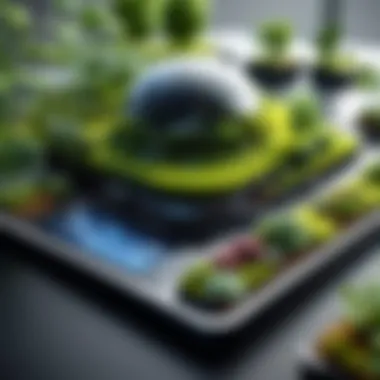
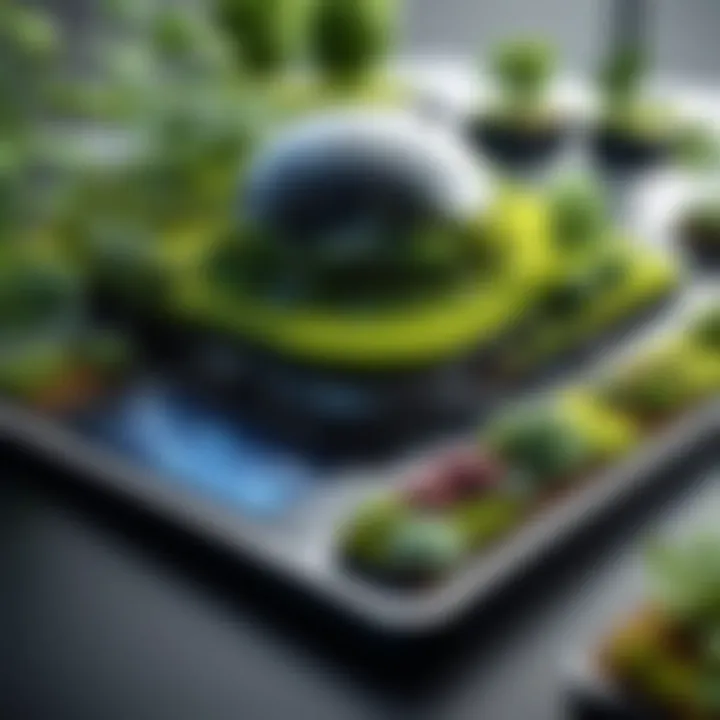
Intro
As we move deeper into the 21st century, our relationship with the environment is becoming increasingly vital. The concept of sustainability is no longer a mere buzzword; it’s a need that resonates in our design practices. The aim of integrating ecological principles into the creative process is straightforward: to promote a harmonious existence between our creations and nature. This is not just about aesthetics or functionality; it’s about shaping a future where our designs are mindful of their impact on the planet.
Despite facing numerous challenges, strides have been made across disciplines. A designer’s role now encompasses more than just creating appealing products or buildings. They must also think about the longevity of materials, resource usage, waste production, and how their designs fit within the larger ecosystem. This article seeks to delve into those intricate relationships, offering insights that not only inform but also inspire.
From technology advancements enhancing sustainable practices to design innovations that challenge convention, the content aims to equip readers with a well-rounded understanding of how their choices can influence environmental outcomes.
To kick things off, let us examine Technology Insights, which highlights the innovative technologies that are transforming sustainable design practices.
Defining Sustainability in Design
Sustainability in design is not just a passing trend; it's a pivotal concept that shapes the future of how we create and consume. By understanding sustainability in this context, we can appreciate its critical role in tackling environmental impacts while driving innovation. At its core, sustainable design is about making decisions that consider environmental implications and social responsibility throughout the design process.
Understanding the Concept
To grasp the meaning of sustainability in design, it’s helpful to break it down into its essential elements. First, sustainability involves understanding the limits of our resources. This means designers must think carefully about the materials they select, seeking out options which are renewable or recyclable.
When talking about design, we also need to put a spotlight on durability. It’s not wise to produce items that have a short shelf life and end up as landfill fodder. A sustainable approach encourages designs that last longer and engage consumers in a dialogue about durability as part of product value.
Moreover, there is a social component. It involves designing with empathy, ensuring that products and structures contribute positively to communities and support equitable practices. Understanding user needs goes hand in hand with ecological mindfulness, making the design's impact multifaceted.
"The goal is to find a happy balance between the demands of the market and the health of our planet, fostering a sense of responsibility in every design choice we make."
Historical Context
Sustainability isn't an entirely fresh concept; its roots can be traced back to early design philosophies during the post-World War era. In the 1960s and 1970s, as awareness of environmental issues grew, designers began advocating for an eco-conscious design ethos. This was a time when people started to realize that industrial progress was closely tied to ecological degradation.
One milestone in this journey was the introduction of the term "sustainable development" in the 1987 Brundtland Report, which emphasized meeting the needs of the present without compromising the ability of future generations to meet their own needs. This pivotal moment galvanized the design community to rethink practices, slowly shifting towards a more sustainable standpoint.
Throughout the years, various design movements such as Arts and Crafts and later, the emergence of eco-design in the late 20th century were influential. They highlighted crafting pieces that resulted in low environmental impact while still being aesthetically appealing.
Today, the significance of historical context is clear. It not only provides lessons on what not to repeat but also highlights the journey towards ecological understanding that has fostered innovation in sustainable design practices.
Understanding where we’ve been can guide us toward where we need to go, presenting valuable insights for aspiring designers focused on both ecological principles and consumer demand.
Principles of Sustainable Design
Integrating ecological principles into creative processes involves a meticulous understanding of sustainable design. At its core, sustainable design is about creating systems, products, and environments that balance human needs and ecological health. This section emphasizes the principles that govern sustainable design, shedding light on essential concepts, their benefits, and the considerations that every designer should keep in mind to ensure their work is not only innovative but also environmentally responsible.
Resource Efficiency
Resource efficiency is a cornerstone of sustainable design. It refers to the judicious use of materials and energy in the design and production processes. By focusing on reducing waste and maximizing the utility of resources, designers can create products that have a lower environmental impact.
- Minimizing Material Use: One of the simplest yet most effective strategies is to cut down on the amount of material used in a product’s life cycle. This can mean designing products that require less raw material—from smaller packaging to simpler designs.
- Recycling and Reusing: Designers increasingly look for ways to repurpose existing materials or use recycled content in their designs. This not only conserves resources but also minimizes landfill waste.
- Energy Efficiency Across the Board: Striving for energy efficiency doesn't stop at the design phase; it extends to manufacturing, transportation, and usage. Products that consume less energy during their life ultimately contribute to a more sustainable future.
Ultimately, resource efficiency isn't just about saving costs; it's also about steering the industry away from practices that harm the planet. As designers embrace this principle, they can profoundly influence how products are conceived and realized, pushing the envelope toward a more sustainable future.
Life Cycle Assessment
Life Cycle Assessment (LCA) is another vital principle in sustainable design. This process evaluates the environmental impact of a product at every stage of its life—from raw material extraction to manufacturing, distribution, and eventual disposal.
"A product's life doesn't just begin and end with its use; it affects our planet from the start to the finish."
- Comprehensive Evaluation: Through LCA, designers can uncover potential environmental pitfalls of their products early in the design phase. Identifying the most significant stages of environmental impact helps direct efforts to minimize harm.
- Informed Choices: An understanding of LCA empowers designers to make informed decisions regarding material choices, energy use, and transportation methods.
- Continuous Improvement: The insights gained through LCA are invaluable for refining future designs, making the design process an iterative learning experience.
By adopting life cycle assessments, designers can create products that not only meet consumer demands but do so in a way that prioritizes planetary health.
Biomimicry
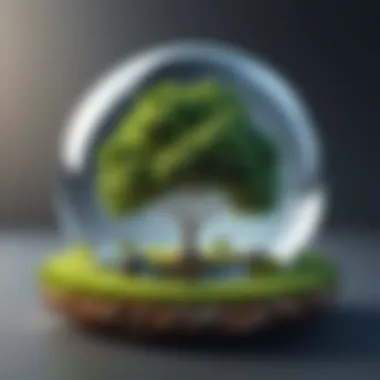
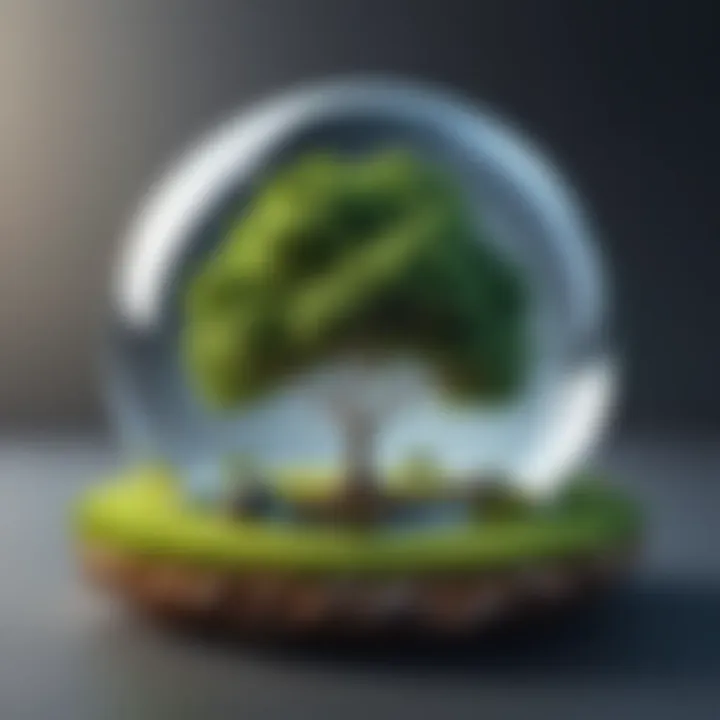
Biomimicry takes inspiration from nature’s designs, processes, and strategies. Instead of reinventing the wheel, designers can look to the vast array of solutions that nature offers. This principle is becoming increasingly popular across various disciplines, blending creativity and sustainability seamlessly.
- Natural Inspiration: Many products we take for granted were inspired by nature, from the Velcro based on burrs clinging to fur to energy-efficient structures mimicking termite mounds.
- Efficient Solutions: Nature has evolved over millions of years, honing solutions that are incredibly efficient. By mimicking these designs, products can achieve better functionality while being kinder to the environment.
- Resilience and Adaptability: Nature's ability to adapt offers invaluable lessons in versatility. Products designed upon these principles can be more durable and relevant over time.
Incorporating biomimicry into the design process allows for innovative solutions that not only solve human problems but do so in alignment with the ecosystem's needs.
By adopting these principles, designers can create work that's more than just attractive or functional; they can pave a way toward regenerative practices that support sustainable living. Each principle provides a framework through which creativity can thrive while the planet can breathe a little easier.
Application Across Disciplines
Understanding Application Across Disciplines is vital for integrating ecological principles into design processes. Various fields, ranging from architecture to fashion, can embed sustainability deeply into their core practices. The true power of design lies in its adaptability; this means that no matter the discipline, sustainable practices can create a ripple effect that influences the environment positively and encourages conscious consumer behavior. By learning how different areas tackle sustainability, designers can share insights and approaches that might not be immediately apparent within their specific fields.
Sustainable Architecture
Green Building Materials
In the realm of sustainable architecture, Green Building Materials play a crucial role. These materials often incorporate renewable resources or recycled products, which significantly reduce the demand on natural resources. Their key characteristic is their ability to lessen the environmental footprint of a building. For instance, bamboo is often touted for its rapid growth cycle, making it a beneficial choice for structures that seek ecological balance.
What makes green materials particularly attractive is their unique feature of being non-toxic, which means they contribute to better indoor air quality. However, they can sometimes be pricier than traditional options. This poses a challenge for those trying to implement sustainable solutions without breaking the bank.
Energy Efficiency Techniques
Similarly, Energy Efficiency Techniques are paramount in reducing energy consumption in buildings. The hallmark of these techniques is their ability to optimize energy use through methods like advanced insulation and energy-efficient windows. This not only lowers utility bills but also mitigates the overall carbon footprint.
These techniques stand out due to their immediate economic benefits—less energy means saved money. However, upfront costs for some energy-efficient products can be a hurdle. Nevertheless, the long-term advantages outweigh the initial investments, often leading to substantial savings in energy costs over time.
Product Design
Eco-Friendly Materials
The exploration of Eco-Friendly Materials is essential in Product Design. These materials prioritize sustainability, from production to end-of-life phase. The key attraction of eco-friendly materials is their minimal impact on the environment, often including things like biodegradable plastics or recycled metals. By opting for these materials, designers can help combat pollution and waste.
A unique aspect of these materials is their versatility; they can be used in everything from electronics to everyday products. However, sourcing these materials can present challenges regarding availability and cost, potentially limiting their use in mainstream products.
Modular Design Concepts
In Product Design, Modular Design Concepts create a pathway for sustainability by making products easier to repair or upgrade. The essence of this concept is that products can be disassembled and reassembled, encouraging longevity and reducing waste.
The beauty of modular design is its flexibility—users can replace or upgrade parts rather than discarding entire products. However, this approach may require a shift in consumer mindset, which can be a significant barrier. It's about educating consumers on the value of investing in quality and sustainable design as opposed to fast, disposable products.
Fashion and Textiles
Sustainable Fabrics
Transitioning into the fashion sphere, Sustainable Fabrics have surged in popularity. Fabrics made from organic cotton, hemp, or recycled materials offer a stark contrast to conventional textiles that are often produced in environmentally damaging ways. The key characteristic here is their reduced ecological footprint, nourishing the planet while providing a multitude of choices for creators.
These fabrics shine for their unique property of being produced with fewer chemicals, making them safer for both the environment and consumers. Yet, the challenge remains: sustainable fabrics can be more expensive and might not always be accessible, thus limiting their widespread adoption.
Ethical Production Practices
Equally important are Ethical Production Practices in the fashion industry. These practices revolve around fairness in wages and working conditions for garment workers. These practices represent a significant shift toward transparency and responsibility in manufacturing, addressing not just environmental concerns, but social ones as well.
The unique feature of ethical production is its potential to empower communities. By investing in sustainable labor practices, brands can create a positive impact beyond environmental sustainability. However, establishing such practices can often mean increased costs, which can deter companies more focused on profit margins than ethical responsibility.
Integrating sustainable practices across various disciplines not only fosters innovation but builds a holistic approach to ecological responsibility.
Technological Innovations Supporting Sustainability
Technological innovations have significantly reshaped the landscape of sustainable design. Their rapid development comes coupled with a growing awareness of environmental issues, allowing designers to incorporate ecological principles into their creative processes more effectively. This integration helps bridge the gap between creativity and responsibility, ensuring that the resources we rely on are used wisely and ethically.


Key innovations in technology have fostered a more eco-conscious design environment, enabling professionals across various fields to create products, buildings, and systems with reduced ecological footprints. These advancements are not just tools; they’re vital components in crafting a more sustainable future, allowing for precise monitoring, forecasting, and optimization in resource management.
Smart Technologies
Smart technologies play a crucial role in the realm of sustainability, focusing on energy efficiency and resource optimization. They not only contribute to reduced waste but also enhance the overall performance of products and structures. Two standout categories in this space are Energy Management Systems and Smart Materials, each pivotal in driving eco-friendly design forward.
Energy Management Systems
Energy Management Systems (EMS) are integral to modern infrastructure. These systems enable real-time monitoring and control over energy consumption, which plays a significant role in sustainability efforts. They allow users to stay informed about energy usage patterns, identifying opportunities for efficiency improvements. One key characteristic of EMS is their ability to integrate with existing systems, providing a seamless transition from traditional management to an eco-conscious approach.
The unique feature of many EMS lies in their predictive capabilities. By analyzing historical data, they can forecast energy needs, leading to better energy purchasing decisions and minimizing costs. However, the initial investment in these systems can be a hurdle for some organizations, even as they promise long-term savings and environmental benefits.
Smart Materials
Smart Materials are another pillar of sustainable design technologies. These materials respond dynamically to environmental changes, enabling adaptable solutions that enhance sustainability. For example, some smart materials can change shape or properties depending on temperature or light, leading to better energy efficiency in buildings and products.
A significant advantage of smart materials is their potential for waste reduction. Instead of creating components that must be modified or disposed of, materials that adapt can extend their usefulness. Yet, the cost and complexity of integrating smart materials into traditional manufacturing processes can be challenging for some designers, potentially stunting widespread adoption in the immediate term.
Digital Design Tools
Digital design tools have revolutionized how designers approach sustainability. They not only streamline the design process but also enhance precision, reduce waste, and facilitate innovative solutions. Among these tools, 3D Printing and Virtual Prototyping stand out as particularly transformative for addressing sustainability challenges.
3D Printing
3D Printing, or additive manufacturing, has made a mark by allowing for the creation of intricate designs with minimal material waste. Unlike traditional subtractive manufacturing, which often involves carving material away, 3D printing builds objects layer by layer, making it extremely efficient. This method reduces waste, a significant plus for eco-conscious designers.
Additionally, 3D printing fosters customization, enabling products to be tailored to specific needs without the surplus that often accompanies mass production. However, one downside is the limitations in material types and strength, making it unsuitable for all applications, yet it continues to evolve as new materials are developed.
Virtual Prototyping
Virtual Prototyping is another excellent advancement for sustainable design practices. This approach enables designers to effectively simulate and test their creations before any physical production occurs, which can save on materials and reduce the risk of faults in the final product.
A vital characteristic of virtual prototyping is its cost-effectiveness. It helps identify issues early in the design phase, preventing expensive alterations after production begins. Nonetheless, there can be a steep learning curve associated with mastering these tools, which could deter some from fully embracing them.
Challenges to Sustainable Design
Navigating the realm of sustainable design isn't all rainbows and butterflies. It comes with its own set of challenges that can be quite the hurdle for designers and companies alike. Understanding these obstacles is crucial not just for industry professionals, but for anyone interested in crafting eco-friendly solutions. Addressing challenges head-on can lead to innovative breakthroughs and pave the way for more sustainable practices.
Economic Constraints
When it boils down to it, money talks. In the world of sustainable design, economic constraints are one of the most significant challenges to overcome. Designers often grapple with the high initial costs associated with sustainable materials and technologies. Take, for instance, the incorporation of recycled materials which can sometimes push the budget beyond what clients are willing to accept. While the long-term benefits of these materials may outweigh the costs, the upfront financial burden can deter stakeholders from investing.
Furthermore, manufacturers and businesses often face pressure to minimize spending to maximize profits, which can lead to cutting corners in sustainability practices. It’s a tricky balancing act between achieving sustainability goals and ensuring financial viability. This can result in compromises that diminish the overall effectiveness of sustainable design efforts.
Consider these elements:
- Higher Costs: Eco-friendly materials may require a larger investment upfront.
- Market Competition: Companies focused on traditional, less sustainable practices often have lower pricing, making it hard for sustainable alternatives to compete.
- Lack of Incentives: In some regions, there may be little to no governmental or institutional support for sustainable initiatives, creating added financial strain.
These factors contribute to a harsh economic landscape for sustainable design, posing serious challenges that need addressing for its broader adoption.
Consumer Behavior
Consumer behavior plays a pivotal role in shaping the landscape of sustainable design. The market is often driven by what consumers choose to buy. Yet, when it comes to sustainable products, there’s a noticeable dissonance. While many consumers express an interest in supporting environmentally friendly initiatives, this doesn’t always translate into purchasing decisions.
One major challenge is the tendency for consumers to prioritize price over sustainability. Eco-friendly products are sometimes perceived as luxuries rather than necessities, pushing them to the back of shopping lists for many consumers.
Thus, understanding consumer motivations is critical. Some insights include:
- Awareness vs. Action: There's a gap between awareness of sustainability issues and actual purchasing behavior.
- Education and Outreach: Many consumers lack sufficient information on the benefits of sustainable choices, making outreach essential.
- Brand Loyalty: Established brands offering non-sustainable options can overshadow newer, eco-friendly alternatives.
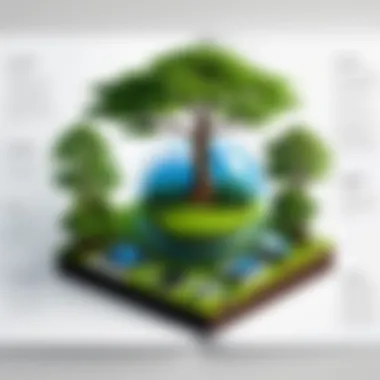
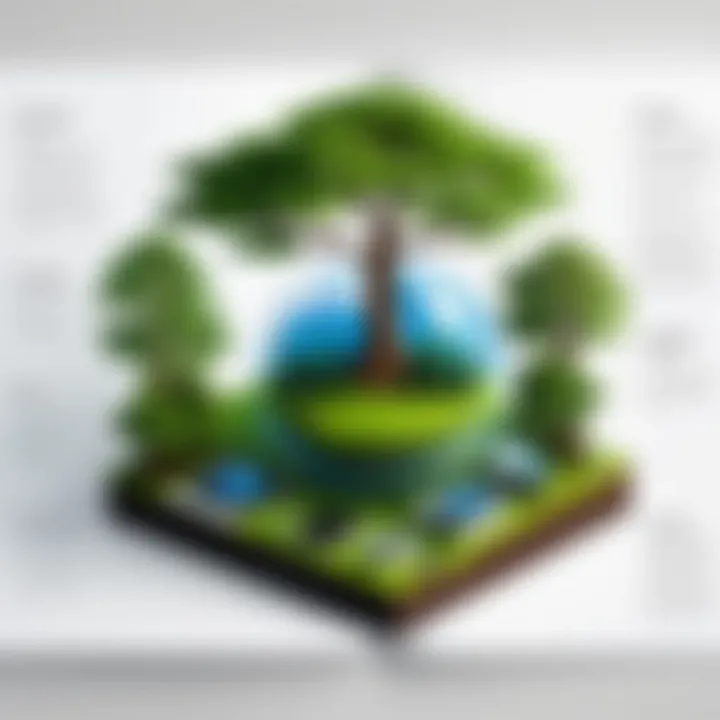
All these elements shape a consumer landscape that can be challenging for sustainable design to navigate. Designers and companies must seek strategies that not only educate consumers but also align product offerings with market demand in a way that drives purchasing decisions toward a more sustainable future.
"Sustainable design isn’t just about making eco-friendly choices; it's about changing behaviors and perceptions in a market that often prioritizes short-term gains over long-term benefits."
In summary, embracing challenges like economic constraints and shifting consumer behavior is essential for the development and implementation of sustainable design. These hurdles may seem daunting, but they also represent opportunities for creativity and innovation in finding solutions that benefit both people and the planet.
Case Studies of Successful Sustainable Design
In the realm of sustainable design, practical evidence speaks louder than theoretical discussions. Case studies of successful sustainable design serve as critical learning tools, providing tangible proof of how innovative practices can marry ecological principles with creative visions. These case studies not only showcase the end results but also emphasize the journey taken to achieve sustainability, highlighting both the challenges faced and the strategies implemented to overcome them. By examining these real-world examples, designers can draw inspiration and gain insights that can influence their own creative processes.
Urban Sustainability Initiatives
Urban areas often face a unique set of challenges concerning sustainability, including pollution, waste management, and energy consumption. However, some cities have successfully turned the tide with initiatives aimed at integrating ecological principles into their fabric.
- Green Roofs and Living Walls: A prominent example is Chicago's Green Roof Initiative, where over 5,400 gardens have been developed on rooftops. Filling cities with greenery helps reduce the heat island effect, enhances air quality, and promotes biodiversity. Such projects reveal how urban spaces can be transformed into micro-ecosystems.
- Sustainable Transportation Systems: In Copenhagen, an ambitious cycling infrastructure has been established, prioritizing bike lanes and connecting routes throughout the city. This initiative has led to a substantial reduction in vehicle emissions and traffic congestion, demonstrating the role of urban design in promoting sustainable transport habits.
- Waste Reduction Programs: San Francisco's zero waste initiative has made significant strides in diverting trash from landfills. By implementing comprehensive recycling and composting programs, the city aims to achieve zero waste by 2030, showing how strategic planning and community engagement can lead to drastic improvements in urban sustainability.
These examples exemplify the essential connections between urban design and sustainability. They illustrate that through thoughtful infrastructure and community-centric initiatives, cities can evolve into more sustainable environments.
Sustainable Product Launches
The product design sector has seen a surge in initiatives that explicitly prioritize ecological impact. Successful sustainable product launches not only adhere to environmentally friendly practices but also resonate deeply with consumers who are increasingly eco-conscious. One such illustrative case is the launch of the Patagonia Worn Wear Program.
- Circular Economy: This initiative encourages the repair and reuse of Patagonia products rather than encouraging consumers to simply purchase new ones. By promoting a circular economy, Patagonia exemplifies how brands can engage customers in sustainable practices while simultaneously fostering loyalties.
- Eco-Friendly Materials: Another noteworthy example is Apple's commitment to using recycled materials in their devices. The company’s devices now use recycled aluminum and cobalt, reducing the need for new mining operations while also inspiring others in the tech industry to reconsider sourcing methods.
- Social Responsibility: In the fashion industry, brands like Reformation feature eco-friendly materials while ensuring ethical labor practices. Their products attract a clientele that values transparency and responsibility. This emphasizes that aligning a product's lifecycle with sustainability can enhance brand reputation and consumer trust.
These product launches highlight the shifting dynamics in consumer behavior, where more buyers demand accountability and sustainability from brands. Such initiatives ensure that sustainability is not merely an afterthought but an integral part of the design and production processes.
"Successful sustainable design isn't just about the product—it's about the entire ecosystem around it."
Ultimately, case studies of successful sustainable design offer valuable lessons, emphasizing that real change is possible through mindful creativity. By taking cues from these initiatives, designers and businesses can pave the way for a more sustainable future.
Future Directions in Sustainable Design
The world of design is constantly evolving, and as it does, the push for sustainable practices grows ever more pressing. This section delves into the vital importance of future directions in sustainable design, highlighting specific elements like emerging trends and the crucial role of policy and regulation. Understanding these dimensions not only enhances the capabilities of designers but fosters a broader culture of ecological responsibility.
Emerging Trends
As designers and consumers alike become more aware of environmental issues, new trends in sustainable design are emerging. These movements often reflect a shift towards innovative practices that emphasize ecological responsibility without sacrificing creativity or aesthetic appeal.
Some notable trends include:
- Circular Design: A shift is being seen towards a model where products are designed with their end-of-life in mind. This means creating items that can be easily disassembled, repaired, or recycled, thereby reducing waste.
- Biophilic Design: This trend emphasizes the integration of natural elements into design. The idea is to create spaces that mimic natural environments, thus fostering a connection between humans and nature.
- Sustainable Materials: Increasingly, designers are turning to biodegradable materials or those that have been sourced ethically. Materials like bamboo, hemp, and reclaimed wood are gaining popularity, reflecting a move towards a more sustainable resource base.
Implementing these trends can enhance the overall integrity of the design process, providing benefits that extend beyond the initial construct to encompass a longer-term vision of sustainability.
The Role of Policy and Regulation
The push for sustainable design is not just a grassroots movement—government policy and regulation play a pivotal role in implementing sustainable practices across industries. Policies can create frameworks that motivate organizations to adopt greener designs. Examples of such regulatory frameworks are:
- Tax Incentives for Sustainable Projects: Governments often offer financial incentives for businesses that prioritize environmentally friendly practices in their designs. By lightening the financial load, these policies encourage innovation and investment in sustainable technologies.
- Building Codes and Standards: Many places are recognizing the importance of sustainable practices through legislative measures. Standards for energy efficiency and the use of sustainable materials in construction and product design are becoming not only recommendations but requirements.
- Public Procurement Policies: Governments can also lead by example by mandating the use of sustainable materials and practices in public projects. This creates a ripple effect, influencing private entities to follow suit in order to remain competitive and relevant.
The interplay between regulation and innovation is complex, yet essential. It ensures that sustainability is not merely an afterthought; it becomes a mainstay of the design process.
By encouraging businesses to engage with sustainable practices, policies can help shape a future where ecological principles are seamlessly integrated into the creative processes. The confluence of emerging trends and supportive regulation highlights the potential that lies ahead in the evolution of sustainable design.
The End
As we draw the curtain on this exploration, the significance of sustainable design becomes undeniably clear. With the pressing challenges of climate change and resource depletion, integrating ecological principles into design is not merely a beneficial practice; it's a necessity. A sustainable approach offers a framework through which designers can create solutions that respect the environment while meeting human needs.
Summing Up the Importance of Sustainable Design
Sustainable design emphasizes a life-cycle perspective that encourages products to be designed with their entire lifespan in mind. This means considering not just the final form of a product but every stage from raw material extraction to production, usage, and disposal. Ultimately, it leads to several key benefits:
- Resource Conservation: Sustainable design helps minimize waste and use of non-renewable resources. This is vital, given the limited nature of our planet’s resources.
- Economic Viability: While implementing sustainable practices may require upfront investment, they often result in long-term cost savings through increased efficiency and reduced waste.
- Enhanced Brand Value: Companies that prioritize sustainability can distinguish themselves in a competitive marketplace by attracting eco-conscious consumers.
- Social Responsibility: Designers have a role to play in advocating for ethical practices, ensuring fair labor standards and responsible sourcing of materials.
- Cultural Shift: By embedding sustainability in design, we help foster a broader culture that prioritizes ecological responsibility and innovation.
In summation, the thread that weaves through this article is the idea that thoughtful design is a powerful ally in the pursuit of sustainability. Getting on board with these principles means recognizing that ecological awareness can influence every creative process, paving the way for a greener future. Embracing sustainable design is a step towards protecting our planet for generations to come, creating not just a better environment but also a richer, more responsible approach to creativity.







